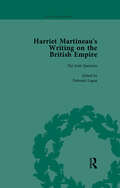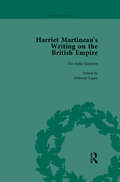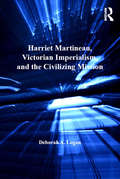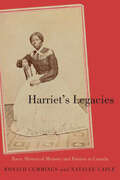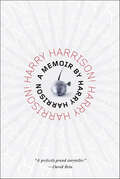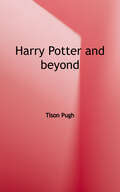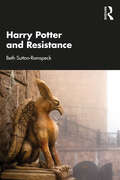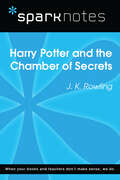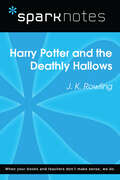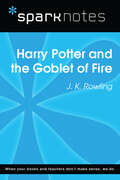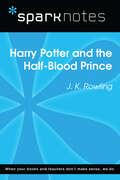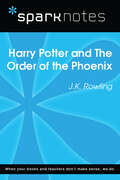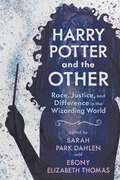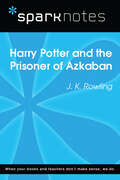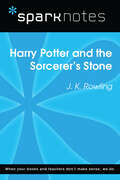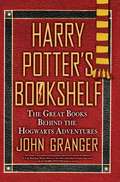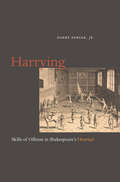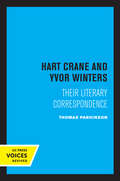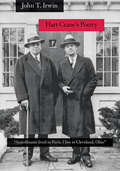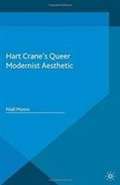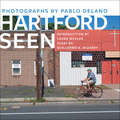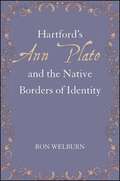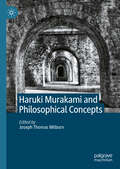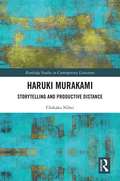- Table View
- List View
Harriet Martineau's Writing on the British Empire, Vol 4
by Patrick Brantlinger Antoinette Burton Deborah Logan Kitty SklarThe literary presence of Harriet Martineau pervades 19th-century English and American culture. This edition makes her work available, and focuses on her writings on imperialism. It should be of interest to scholars of colonialism, women's writing, Victorian studies, sociology and journalism.
Harriet Martineau's Writing on the British Empire, Vol 5
by Patrick Brantlinger Antoinette Burton Deborah Logan Kitty SklarThe literary presence of Harriet Martineau pervades 19th-century English and American culture. This edition makes her work available, and focuses on her writings on imperialism. It should be of interest to scholars of colonialism, women's writing, Victorian studies, sociology and journalism.
Harriet Martineau, Victorian Imperialism, and the Civilizing Mission
by Deborah A. LoganIn her in-depth study of Harriet Martineau's writings on the evolution of the British Empire in the nineteenth century, Deborah A. Logan elaborates the ways in which Martineau's works reflect Victorian concerns about radically shifting social ideologies. To understand Martineau's interventions into the Empire Question, Logan argues, is to recognize her authority as an insightful political commentator, historian, economist, and sociologist whose eclectic studies and intellectual curiosity positioned her as a shrewd observer and recorder of the imperial enterprise. Logan's primary sources are Martineau's nonfiction works, particularly those published in periodicals, complemented by telling references from Martineau's didactic fiction, correspondence, and autobiography. Key texts include History of The Peace; Letters from Ireland and Endowed Schools of Ireland; Illustrations of Political Economy; Eastern Life, Present and Past; and History of British Rule in India and Suggestions for the Future Rule of India. Logan shows Martineau negotiating the inevitable conflict that arises when the practices of Victorian imperialism are measured against its own stated principles, and especially against Martineau's idea of both the Civilizing Mission and the indigenous cultural integrity often compromised in the process. The picture of Martineau that emerges is complex and fascinating. Both an advocate and a critic of British imperialism, Martineau was a persistent champion of the Civilizing Mission. Written with an awareness that she was recording contemporary history for future generations, Martineau’s commentary on this perpetually fascinating, often tragic, and always instructive chapter in British and world history offers important insights that enhance and complicate our understanding of imperialism and globalization.
Harriet’s Legacies: Race, Historical Memory, and Futures in Canada (Carleton Library Series)
by Ronald Cummings and Natalee CapleHistoric freedom fighter and conductor of the Underground Railroad Harriet Tubman risked her life to ferry enslaved people from America to freedom in Canada. Her legacy instigates and orients this exploration of the history of Black lives and the future of collective struggle in Canada.Harriet’s Legacies recuperates the significance of Tubman’s time in Canada as more than just an interlude in her American narrative: it is a new point from which to think about Black diasporic mobilities, possibilities, and histories. Through essays and creative works this collection articulates new territory for Tubman in relation to the Black Atlantic archive, connecting her legacies of survival, freedom, and cultural expression within a transnational framework. Contributors take up the question of legacy in ways that remap discourses of genealogy and belonging, positioning Tubman as an important part of today’s freedom struggles. Integrating scholarship with creative and curatorial practices, the volume expands conversations about culture and expression in African Canadian life across art, literature, performance, politics, and public pedagogy.Considering questions of culture, community, and futures, Harriet’s Legacies explores what happened in the wake of Tubman’s legacy and situates Canada as a key part of that dialogue.
Harry Harrison! Harry Harrison!: A Memoir
by Harry HarrisonIn Harry Harrison! Harry Harrison! are the recollections of one of the grand masters of science fiction, on his storied career as a celebrated author and on his relationships with other luminaries in the field. This memoir is filled with all the humor and irreverence Harry Harrison's readers have come to expect from the New York Times bestselling author of the uproarious Stainless Steel Rat series. This also includes black and white photos spanning his sixty-year career.At the Publisher's request, this title is being sold without Digital Rights Management Software (DRM) applied.
Harry Potter and Beyond: On J. K. Rowling's Fantasies and Other Fictions
by Tison PughHarry Potter and Beyond explores J. K. Rowling's beloved best-selling series and its virtuoso reimagining of British literary traditions. Weaving together elements of fantasy, the school-story novel, detective fiction, allegory, and bildungsroman, the Harry Potter novels evade simplistic categorization as children's or fantasy literature. Because the Potter series both breaks new ground and adheres to longstanding narrative formulas, readers can enhance their enjoyment of these epic adventures by better understanding their place in literary history. <p><p>Along with the seven foundational novels of the Harry Potter series, Harry Potter and Beyond assesses the extraordinary range of supplementary material concerning the young wizard and his allies, including the films of the books, the subsequent film series of Fantastic Beasts and Where to Find Them, the theatrical spectacle Harry Potter and the Cursed Child, and a range of other Potter-inspired narratives. Beyond the world of Potter, Pugh surveys Rowling's literary fiction The Casual Vacancy and her detective series featuring Cormoran Strike, written under the pseudonym Robert Galbraith. Through this comprehensive overview of Rowling's body of work, Pugh reveals the vast web of connections between yesteryear's stories and Rowling's vivid creations.
Harry Potter and Resistance
by Beth Sutton-RamspeckAlthough rule breaking in Harry Potter is sometimes dismissed as a distraction from Harry’s fight against Lord Voldemort, Harry Potter and Resistance makes the case that it is central to the battle against evil. Far beyond youthful hijinks or adolescent defiance, Harry’s rebellion aims to overcome problems deeper and more widespread than a single malevolent wizard. Harry and his allies engage in a resistance movement against the corruption of the Ministry of Magic as well as against the racist social norms that gave rise to Voldemort in the first place. Dumbledore’s Army and the Order of the Phoenix employ methods echoing those utilized by World War II resistance fighters and by the U.S. Civil Rights movement. The aim of this book is to explore issues that speak to our era of heightened political awareness and resistance to intolerance. Its interdisciplinary approach draws on political science, psychology, philosophy, history, race studies, and women’s studies, as well as newer interdisciplinary fields such as resistance studies, disgust studies, and creativity studies.
Harry Potter and the Chamber of Secrets (SparkNotes Literature Guide Series)
by SparkNotesHarry Potter and the Chamber of Secrets (SparkNotes Literature Guide) by J.K. Rowling Making the reading experience fun! Created by Harvard students for students everywhere, SparkNotes is a new breed of study guide: smarter, better, faster.Geared to what today's students need to know, SparkNotes provides:chapter-by-chapter analysis explanations of key themes, motifs, and symbols a review quiz and essay topics Lively and accessible, these guides are perfect for late-night studying and writing papers.
Harry Potter and the Deathly Hallows (SparkNotes Literature Guide Series)
by SparkNotesHarry Potter and the Deathly Hallows (SparkNotes Literature Guide) by J.K. Rowling Making the reading experience fun! Created by Harvard students for students everywhere, SparkNotes is a new breed of study guide: smarter, better, faster.Geared to what today's students need to know, SparkNotes provides:chapter-by-chapter analysis explanations of key themes, motifs, and symbols a review quiz and essay topics Lively and accessible, these guides are perfect for late-night studying and writing papers.
Harry Potter and the Goblet of Fire (SparkNotes Literature Guide Series)
by SparkNotesHarry Potter and the Goblet of Fire (SparkNotes Literature Guide) by J.K. Rowling Making the reading experience fun! Created by Harvard students for students everywhere, SparkNotes is a new breed of study guide: smarter, better, faster.Geared to what today's students need to know, SparkNotes provides:chapter-by-chapter analysis explanations of key themes, motifs, and symbols a review quiz and essay topics Lively and accessible, these guides are perfect for late-night studying and writing papers.
Harry Potter and the Half-Blood Prince (SparkNotes Literature Guide Series)
by SparkNotesHarry Potter and the Half-Blood Prince (SparkNotes Literature Guide) by J.K. Rowling Making the reading experience fun! Created by Harvard students for students everywhere, SparkNotes is a new breed of study guide: smarter, better, faster.Geared to what today's students need to know, SparkNotes provides:chapter-by-chapter analysis explanations of key themes, motifs, and symbols a review quiz and essay topics Lively and accessible, these guides are perfect for late-night studying and writing papers.
Harry Potter and the Order of the Phoenix (SparkNotes Literature Guide Series)
by SparkNotesHarry Potter and the Order of the Phoenix (SparkNotes Literature Guide) by J.K. Rowling Making the reading experience fun! Created by Harvard students for students everywhere, SparkNotes is a new breed of study guide: smarter, better, faster.Geared to what today's students need to know, SparkNotes provides:chapter-by-chapter analysis explanations of key themes, motifs, and symbols a review quiz and essay topics Lively and accessible, these guides are perfect for late-night studying and writing papers.
Harry Potter and the Other: Race, Justice, and Difference in the Wizarding World (Children's Literature Association Series)
by Sarah Park Dahlen and Ebony Elizabeth ThomasNamed a 2023 Honour Book by the International Research Society for Children's LiteratureContributions by Christina M. Chica, Kathryn Coto, Sarah Park Dahlen, Preethi Gorecki, Tolonda Henderson, Marcia Hernandez, Jackie C. Horne, Susan E. Howard, Peter C. Kunze, Florence Maätita, Sridevi Rao, Kallie Schell, Jennifer Patrice Sims, Paul Spickard, Lily Anne Welty Tamai, Ebony Elizabeth Thomas, Jasmine Wade, Karin E. Westman, and Charles D. Wilson Race matters in the fictional Wizarding World of the Harry Potter series as much as it does in the real world. As J. K. Rowling continues to reveal details about the world she created, a growing number of fans, scholars, readers, and publics are conflicted and concerned about how the original Wizarding World—quintessentially white and British—depicts diverse and multicultural identities, social subjectivities, and communities. Harry Potter and the Other: Race, Justice, and Difference in the Wizarding World is a timely anthology that examines, interrogates, and critiques representations of race and difference across various Harry Potter media, including books, films, and official websites, as well as online forums and the classroom. As the contributors to this volume demonstrate, a deeper reading of the series reveals multiple ruptures in popular understandings of the liberatory potential of the Potter series. Young people who are progressive, liberal, and empowered to question authority may have believed they were reading something radical as children and young teens, but increasingly they have raised alarms about the series’ depiction of peoples of color, cultural appropriation in worldbuilding, and the author’s antitrans statements in the media. Included essays examine the failed wizarding justice system, the counterproductive portrayal of Nagini as an Asian woman, the liberation of Dobby the elf, and more, adding meaningful contributions to existing scholarship on the Harry Potter series. As we approach the twenty-fifth anniversary of the publication of Harry Potter and the Philosopher’s Stone, Harry Potter and the Other provides a smorgasbord of insights into the way that race and difference have shaped this story, its world, its author, and the generations who have come of age during the era of the Wizarding World.
Harry Potter and the Prisoner of Azkaban (SparkNotes Literature Guide Series)
by SparkNotesHarry Potter and the Prisoner of Azkaban (SparkNotes Literature Guide) by J.K. Rowling Making the reading experience fun! Created by Harvard students for students everywhere, SparkNotes is a new breed of study guide: smarter, better, faster.Geared to what today's students need to know, SparkNotes provides:chapter-by-chapter analysis explanations of key themes, motifs, and symbols a review quiz and essay topics Lively and accessible, these guides are perfect for late-night studying and writing papers.
Harry Potter and the Sorcerer's Stone (SparkNotes Literature Guide Series)
by SparkNotesHarry Potter and the Sorcerer's Stone (SparkNotes Literature Guide) by J.K. Rowling Making the reading experience fun! Created by Harvard students for students everywhere, SparkNotes is a new breed of study guide: smarter, better, faster.Geared to what today's students need to know, SparkNotes provides:chapter-by-chapter analysis explanations of key themes, motifs, and symbols a review quiz and essay topics Lively and accessible, these guides are perfect for late-night studying and writing papers.
Harry Potter's Bookshelf: The Great Books Behind the Hogwarts Adventures
by John GrangerThis literary companion to the Harry Potter series examines the influence of such writers as Charles Dickens, C.S. Lewis and Jane Austen on the prose of J.K. Rowling. Granger has previously written about the growing importance of the Potter series in academic circles, and he provides both fans and literary scholars with thematic links to such works as Gulliver's Travels and The Adventures of Huckleberry Finn. The author also draws distinctions between the surface meanings in the books and the moral, allegorical and mythological undertones. Annotation ©2009 Book News, Inc., Portland, OR (booknews.com)
Harry the Hopper: Targeting the h Sound (Speech Bubbles 2)
by Melissa PalmerHarry loves to hop, and believes he is a ‘hopper’ – but not everyone agrees… This picture book targets the /h/ sound and is part of Speech Bubbles 2, a series of picture books that target specific speech sounds within the story. The series can be used for children receiving speech therapy, for children who have a speech sound delay/disorder, or simply as an activity for children’s speech sound development and/or phonological awareness. They are ideal for use by parents, teachers or caregivers. Bright pictures and a fun story create an engaging activity perfect for sound awareness. Picture books are sold individually, or in a pack. There are currently two packs available – Speech Bubbles 1 and Speech Bubbles 2. Please see further titles in the series for stories targeting other speech sounds.
Harrying: Skills of Offense in Shakespeare's Henriad
by Harry BergerHarrying considers Richard III and the four plays of Shakespeare’s Henriad—Richard II, Henry IV Part 1, Henry IV Part 2, and Henry V. Berger combines close reading with cultural analysis to show how the language characters speak always says more than the speakers mean to say. Shakespeare’s speakers try to say one thing. Their language says other things that often question the speakers’ motives or intentions. Harrying explores the effect of this linguistic mischief on the representation of all the Henriad’s major figures.It centers attention on the portrayal of Falstaff and on the bad faith that darkens the language and performance of Harry, the Prince of Wales who becomes King Henry V.
Hart Crane and Yvor Winters: Their Literary Correspondence
by Thomas ParkinsonThis title is part of UC Press's Voices Revived program, which commemorates University of California Press’s mission to seek out and cultivate the brightest minds and give them voice, reach, and impact. Drawing on a backlist dating to 1893, Voices Revived makes high-quality, peer-reviewed scholarship accessible once again using print-on-demand technology. This title was originally published in 1978.
Hart Crane's Poetry: "Appollinaire lived in Paris, I live in Cleveland, Ohio"
by John T. IrwinHonorable Mention, Literature, 2012 PROSE Awards, Professional and Scholarly Publishing Division of the Association of American Publishers2012 Outstanding Academic Title, Choice MagazineIn one of his letters Hart Crane wrote, "Appollinaire lived in Paris, I live in Cleveland, Ohio," comparing—misspelling and all—the great French poet’s cosmopolitan roots to his own more modest ones in the midwestern United States. Rebelling against the notion that his work should relate to some European school of thought, Crane defiantly asserted his freedom to be himself, a true American writer. John T. Irwin, long a passionate and brilliant critic of Crane, gives readers the first major interpretation of the poet’s work in decades. Irwin aims to show that Hart Crane’s epic The Bridge is the best twentieth-century long poem in English. Irwin convincingly argues that, compared to other long poems of the century, The Bridge is the richest and most wide-ranging in its mythic and historical resonances, the most inventive in its combination of literary and visual structures, the most subtle and compelling in its psychological underpinnings. Irwin brings a wealth of new and varied scholarship to bear on his critical reading of the work—from art history to biography to classical literature to philosophy—revealing The Bridge to be the near-perfect synthesis of American myth and history that Crane intended.Irwin contends that the most successful entryway to Crane’s notoriously difficult shorter poems is through a close reading of The Bridge. Having admirably accomplished this, Irwin analyzes Crane’s poems in White Buildings and his last poem, "The Broken Tower," through the larger context of his epic, showing how Crane, in the best of these, worked out the structures and images that were fully developed in The Bridge.Thoughtful, deliberate, and extraordinarily learned, this is the most complete and careful reading of Crane’s poetry available. Hart Crane may have lived in Cleveland, Ohio, but, as Irwin masterfully shows, his poems stand among the greatest written in the English language.
Hart Crane's Queer Modernist Aesthetic
by Niall MunroHart Crane's Queer Modernist Aesthetic argues that the aspects of experience which modernists sought to interrogate - time, space, and material things - were challenged further by Crane's queer poetics. Reading Crane alongside contemporary queer theory shows how he creates an alternative form of modernism.
Hartford Seen (Hartford Books)
by Pablo DelanoHartford Seen is the first modern-day art photography book focused exclusively on Connecticut's capital city. Born and raised in Puerto Rico, Pablo Delano relocated from Manhattan to Hartford in 1996 to teach photography at Trinity College. On his daily drive to work, he was struck continually by the city's visual beauty and complexity. He left the car and began to explore, using his camera as a means of gaining a deeper understanding of what he found. In this personal meditation on Harford's built environment, Delano implements a methodical but intuitive approach, scrutinizing the layers of history embedded in the city's fabric. He documents commercial establishments, industrial sites, places of worship, and homes with a painter's eye to color and composition. His vision tends to eschew the city's better-known landmarks in favor of vernacular structures that reflect the tastes and needs of the city's diverse population at the dawn of the 21st Century. Over the last 100 years Hartford may have transformed from one of America's wealthiest cities to one of its poorest, but as suggested by Hartford Seen, today it nevertheless enjoys extraordinary cultural offerings, small entrepreneurship, and a vibrant spiritual life. The city's historical palette consists mostly of the brownstone, redbrick, and gray granite shades common in New England's older cities. Yet Delano perceives that it is also saturated with the blazing hues favored by many of its newer citizens. With more than 150 full-color images,Hartford Seen vitally expands the repertoire of photographic studies of American cities and of their contemporary built environments.
Hartford's Ann Plato and the Native Borders of Identity
by Ron WelburnWho was Ann Plato? Apart from circumstantial evidence, there's little information about the author of Essays; Including Biographies and Miscellaneous Pieces, in Prose and Poetry, published in 1841. Plato lived in a milieu of colored Hartford, Connecticut, in the early nineteenth century. Although long believed to have been African American herself, she may also, Ron Welburn argues, have been American Indian, like the father in her poem "The Natives of America." Combining literary criticism, ethnohistory, and social history, Welburn uses Plato as an example of how Indians in the Long Island Sound region adapted and prevailed despite the contemporary rhetoric of Indian disappearance. This study seeks to raise Plato's profile as an author as well as to highlight the dynamics of Indian resistance and isolation that have contributed to her enigmatic status as a literary figure.
Haruki Murakami and Philosophical Concepts
by Joseph Thomas MilburnThis book provides interdisciplinary perspectives on the work of the Japanese writer Haruki Murakami, with a particular focus on the conceptual material of his work. It seeks to answer the following questions: Is there any philosophic material or concepts in the work of Haruki Murakami? If so, why are they important? Does philosophic engagement add anything to the Murakami research field? Equally, does Murakami&’s fiction present us with anything valuable for the field of philosophy? The volume uniquely develops the field of Murakami studies through acting as a forum for interdisciplinary researchers to share their perspective on his work. Importantly, it furthers the conversation on Murakami&’s philosophic value and through doing so, is a must-read not only for those interested in Japanese literature or culture, but also for those interested in the productive space existing at the intersection of philosophy, literature, and psychoanalysis.
Haruki Murakami: Storytelling and Productive Distance (Routledge Studies in Contemporary Literature)
by Chikako NiheiHaruki Murakami: Storytelling and Productive Distance studies the evolution of the monogatari, or narrative and storytelling in the works of Haruki Murakami. Author Chikako Nihei argues that Murakami’s power of monogatari lies in his use of distancing effects; storytelling allows individuals to "cross" into a different context, through which they can effectively observe themselves and reality. His belief in the importance of monogatari is closely linked to his generation’s experience of the counter-‐‑culture movement in the late1960s and his research on the 1995 Tokyo Sarin Gas Attack caused by the Aum shinrikyo cult, major events in postwar Japan that revealed many people’s desire for a stable narrative to interact with and form their identity from.
